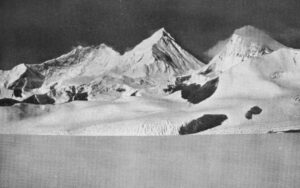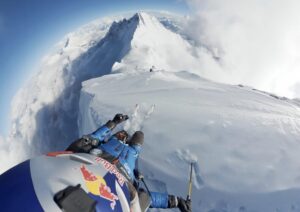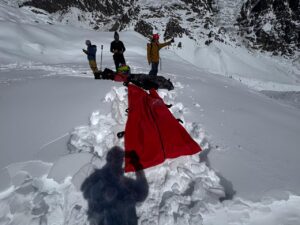The monsoon refuses to recede and is increasing risk even for trekkers in Nepal. Last week, the bad weather ended all expeditions on Everest, Manaslu, and Dhaulagiri, but the danger reaches well beyond those upper slopes.

Larke Pass, near Manaslu Base Camp on a good day. Photo: Adventure Vision Treks and Travels
October is high trekking season in the post-monsoon, but the unceasing rain and snow have affected numerous groups, especially in Western Nepal. Most of all, in the higher passes on the treks to Dhaulagiri and Manaslu.

Trekking areas in Nepal. Map: MountainIQ
Avalanche kills one at Larke Pass
Flor Cuenca of Peru stopped in Samagaon for a couple of days after her Manaslu attempt ended on October 2. She hoped to recover from a bad cold before trekking to her next goal, Himlung.
“The weather only got worse,” she explained to ExplorersWeb. “Soon we heard that Larke Pass on the way to Himlung [and on the regular Manaslu trekking circuit] was closed. Many trekkers stopped at Samagaon. Others returned to the village after they found the trail closed.”
Cuenca’s symptoms worsened and she finally caught a helicopter to a village downvalley where she could catch a bus, so she didn’t trek all the way. But she confirmed that heavy rains and mudslides have caused serious problems in many parts of the country. She also canceled her Himlung expedition totally. In addition to her lingering ailment, there have been several landslides above Dharapani village.
Larke Pass has had the worse incident so far. A local guide (name unknown) died in an avalanche yesterday. Searchers found his lifeless body today. Two Sherpas also fell into a crevasse somewhere in the region. They have not yet been retrieved.
Missing trekkers in Dolpo
Today, at least eight French trekkers have been reported missing in Upper Dolpo (Dolpa), The Himalayan Times reports. Their outfitting company says that they were between Saldang (Salding) and Dho Tarang (Dho Tarap), but that is a very big area.
Helicopters searched for them today until bad weather forced them back. Four British and their guide also needed rescue in Dolpo yesterday. Dolpo lies in wilder, less visited Western Nepal. Unlike other areas, lodging facilities are uncommon, so trekking groups need porters and camping facilities.

Stages of the Upper Dolpo trek. Map: Satori Adventures
Other trekkers did not run into danger but found themselves stranded in small villages with nowhere to stay. Heavy snowfall shut the mountain passes, forcing too many groups to accumulate in those small hamlets with limited lodging.
The bad weather has even affected the well-developed Everest region. Groups in Kathmandu have had to postpone their departure for the Khumbu Valley because bad weather has grounded their flights to Lukla. For example, Juan Oiarzabal, a past 14×8,000m summiter, has been stranded in Kathmandu for an extra two days with the group that he is leading.
“We will try again tomorrow, provided planes fly — but the weather is pfff,” he said.






